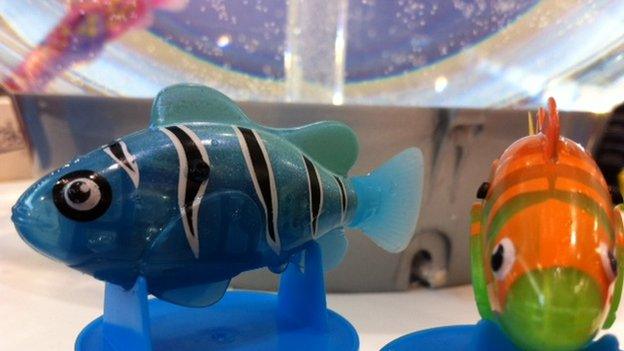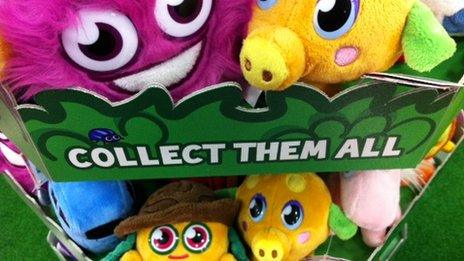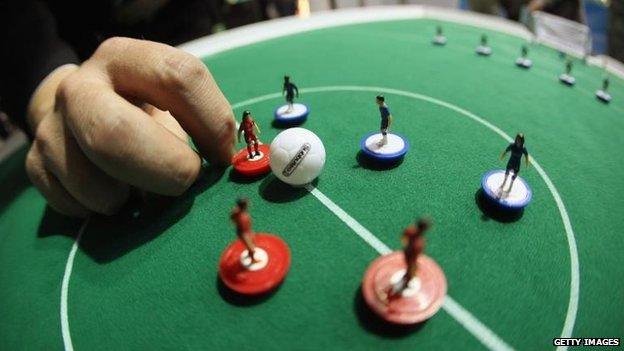Toy firms aim to get children hooked on brand loyalty
- Published

Robo Fish come in a range of different colours that can be collected separately
One of the newcomers on the toy scene last year was the Robo Fish - a colourful, battery-operated plastic animal that automatically swims around the moment you drop it into a bowl of water. "Even the cat can't tell the difference", the sales patter suggests.
The initial set of a fish, a bowl, and a spare set of batteries will cost parents about £20, but that's not the end of it.
The back of the box displays all eight fish in the range and encourages enthusiasts to "collect them all".
If youngsters are hooked, and parents are reeled in by their children, each extra fish will cost them about £10.
Of course, the Robo Fish is just one toy among thousands that encourage young consumers to be loyal to a brand.
'Healthy' for business
At the British Toy and Hobby Association's Toy Fair, open in London this week, toy companies are displaying their hopes for hits during 2014, including key Christmas sales.

Collections can be "healthy for business", says one analyst
Stroll around the stalls and visitors will see scores of collectables at pocket-money prices, but also toy collections which - with a variation on a theme - target repeat sales.
That can be anything from fluffy Moshi Monsters to Bollywood stars dolls.
The price range can be vast - the Barbie dolls range, for example, can cost anything from £7 to £200.
These collections can be healthy for business, according to Frederique Tutt, global toy industry analyst with the NPD Group.
"It is about penetration into the brand," she says. "If kids are collecting something, then they will go back."
'Pester power'
That can mean pressure on parents to buy more, which can hit the finances fairly hard.
They will tell you that they already feel the pinch when faced with sticker books that feature all the other albums in the set on the back cover, or buying new games for electronic consoles that rarely come cheap.
Jeremy Todd, chief executive of parenting charity Family Lives, says mother and fathers need to learn how to resist these demands.
"Pester power is just a fancy description of when children and young people are desperate for the new fad," he says.
"Companies have realised how powerful children and young people are as consumers. Many marketing and advertising campaigns aggressively target children and young people."
He says spending time with - rather than money on - children can be more productive.
"Although it doesn't feel like it at times, as the parent or carer, you are the most valuable resource for your child and any creative time you spend together is worth more than anything you buy," he says.
The charity's tips to counter pester power include being firm when saying no, rather than haggling with a child, but understanding the pressure children feel in keeping up with the latest fashions.
Steph McGovern tries out the Crazy Cart
Sales of "pocket-money toys", which cost less than £5, dropped by 12% in 2013, according to the NPD Group.
It suggests that less impulse buying is one reason for this fall, showing that many parents were able to resist this pester power.
Fewer but bigger
That said, industry figures show that friends and family still said yes to youngsters on a regular basis.
There were 38 toys sold per child, on average, in the UK last year - and 364 million toys sold in total over the course of the year.
The toy market in 2013 was worth about £2.9bn, with about a third of sales coming at Christmas.
The NPD figures show that while the number of toys sold was down 5%, the average price of a toy rose from £7.52 in 2012 to £7.92 in 2013.
In other words, parents were spending their money on fewer, larger items.
All of this makes the pursuit of brand loyalty even more important for toy companies.
This tactic goes back decades, according to Robert Opie, founder of the Museum of Brands, Packaging and Advertising. He says that character merchandise can be traced back to the cartoons of the 1920s, such as Felix the Cat.
Pester power was in full flow when children wanted to build up their collection of cigarette cards, he adds. And this accelerated as parents' disposable income grew over the years.

Lovers of Subbuteo can buy players painted in the kit of their favourite team
More recently, successful brands such as Lego, motor-racing game Scalextric, and finger-football favourite Subbuteo were all based on a concept that more parts or teams could be bought over time to improve playability.
Many exhibitors at the toy fair stress that younger age groups are easier to attract to toys and games, before technology and fashion compete for their attention.
So it may become more important to establish that brand loyalty even earlier, perhaps linking to a film or television series.
And yet the toy industry knows that a good idea - even if it is a one-off purchase - can be the driving force behind a successful Christmas.
One toy tipped to do well this year is a doll, expected to sell for a relatively expensive £60, that can answer children's questions by looking them up on the internet.
"The toy sector is fast-moving and innovative, launching thousands of new products to market every year," says Natasha Crookes, director of the British Toy and Hobby Association.
"The trade remains confident that the toy market has a good growth potential over the coming years and is really keen to start afresh in 2014."